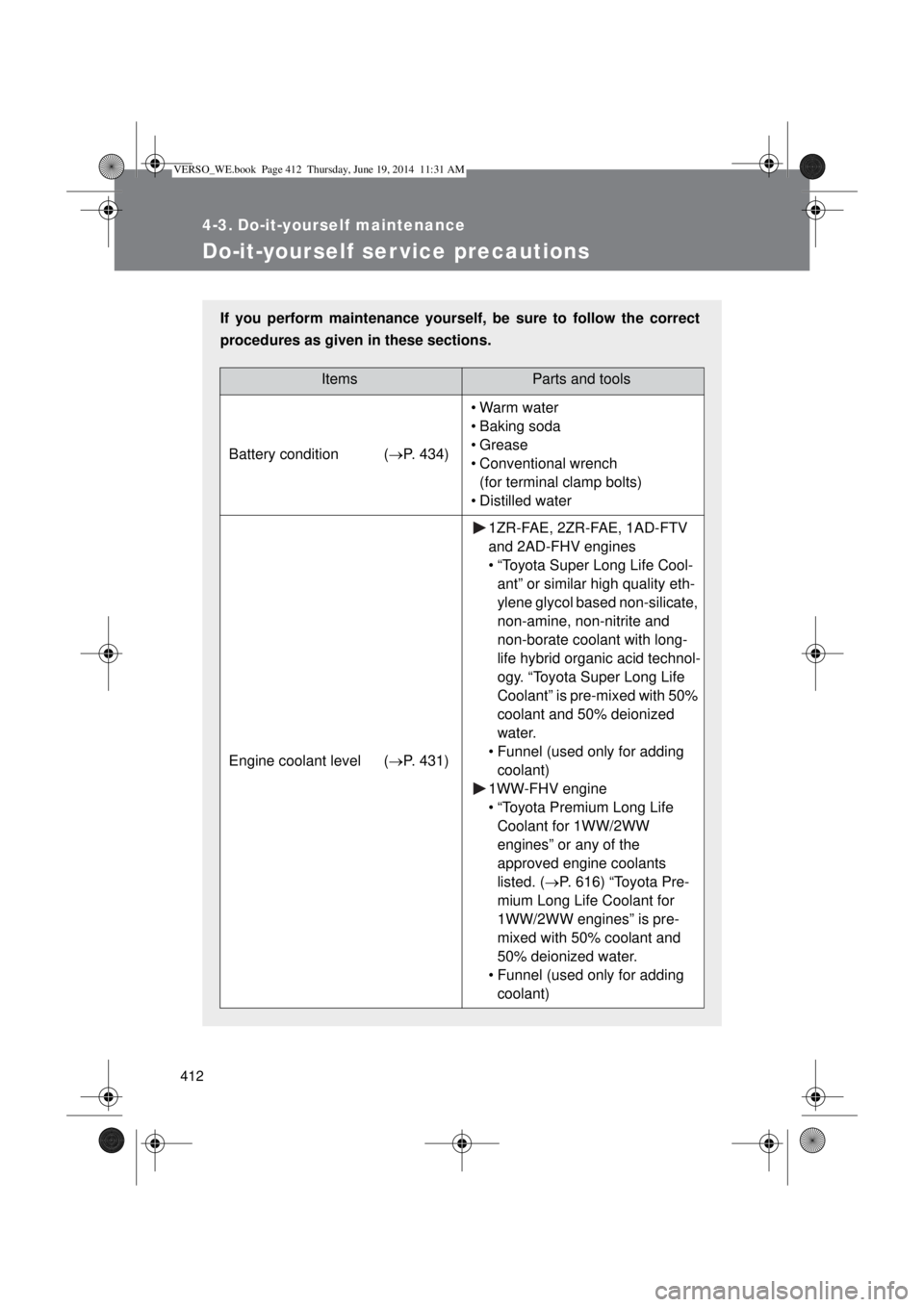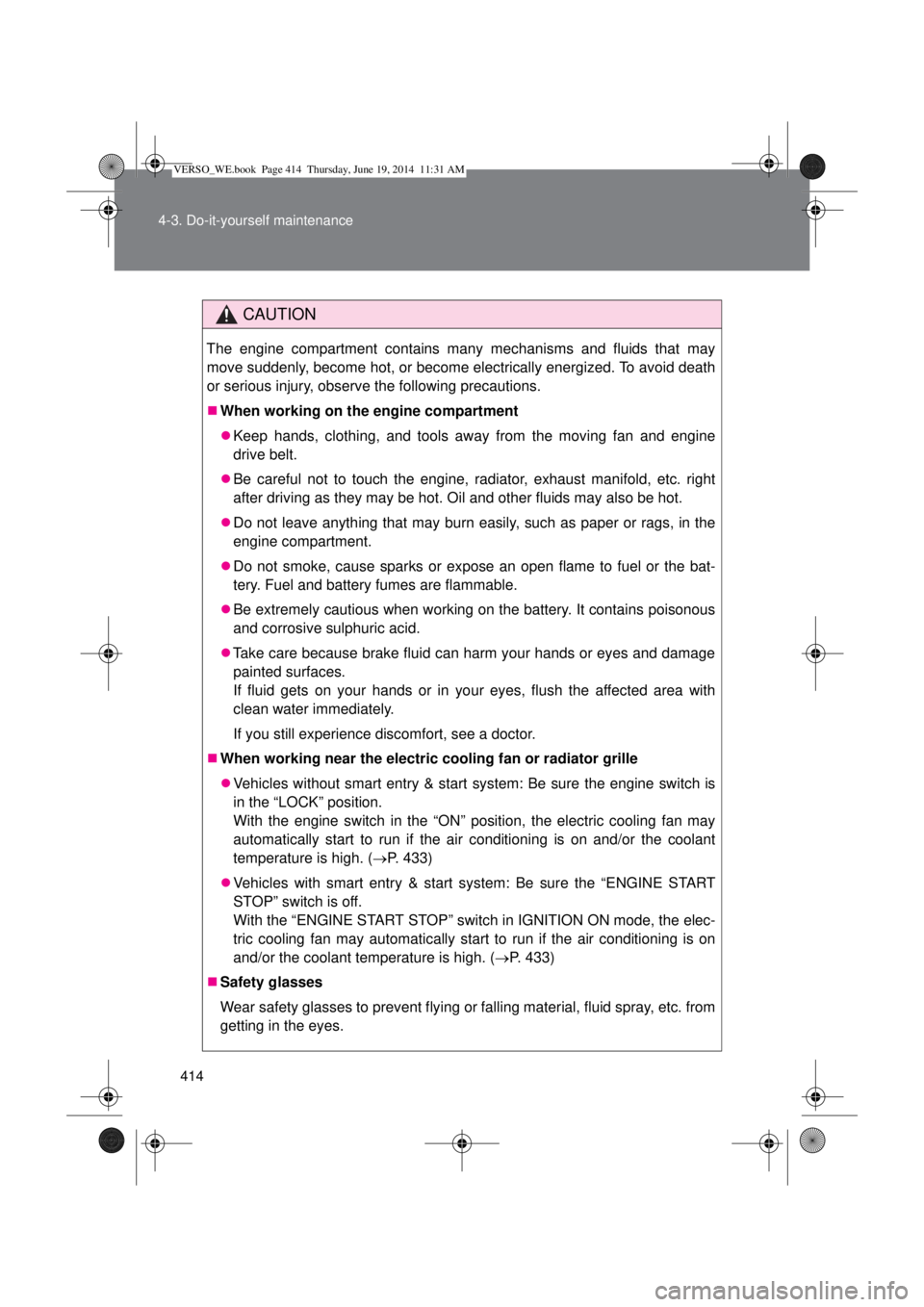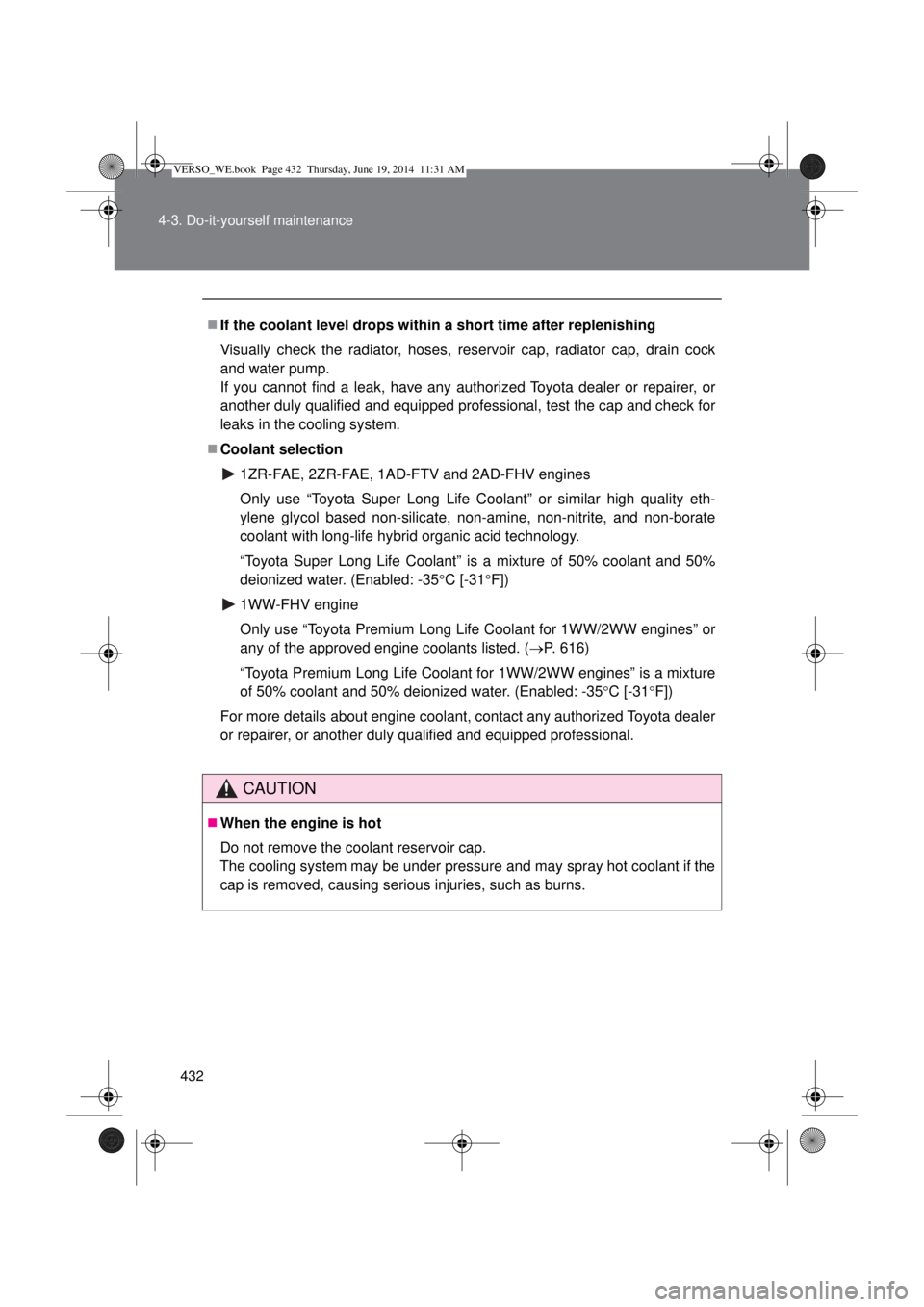Page 412 of 650

412
4-3. Do-it-yourself maintenance
Do-it-yourself ser vice precautions
If you perform maintenance yourself, be sure to follow the correct
procedures as given in these sections.
ItemsParts and tools
Battery condition (P. 434)
• Warm water
• Baking soda
• Grease
• Conventional wrench
(for terminal clamp bolts)
• Distilled water
Engine coolant level (P. 431)
1ZR-FAE, 2ZR-FAE, 1AD-FTV
and 2AD-FHV engines
• “Toyota Super Long Life Cool-
ant” or similar high quality eth-
ylene glycol based non-silicate,
non-amine, non-nitrite and
non-borate coolant with long-
life hybrid organic acid technol-
ogy. “Toyota Super Long Life
Coolant” is pre-mixed with 50%
coolant and 50% deionized
water.
• Funnel (used only for adding
coolant)
1WW-FHV engine
• “Toyota Premium Long Life
Coolant for 1WW/2WW
engines” or any of the
approved engine coolants
listed. (P. 616) “Toyota Pre-
mium Long Life Coolant for
1WW/2WW engines” is pre-
mixed with 50% coolant and
50% deionized water.
• Funnel (used only for adding
coolant)
VERSO_WE.book Page 412 Thursday, June 19, 2014 11:31 AM
Page 414 of 650

414 4-3. Do-it-yourself maintenance
CAUTION
The engine compartment contains many mechanisms and fluids that may
move suddenly, become hot, or become electrically energized. To avoid death
or serious injury, observe the following precautions.
When working on the engine compartment
Keep hands, clothing, and tools away from the moving fan and engine
drive belt.
Be careful not to touch the engine, radiator, exhaust manifold, etc. right
after driving as they may be hot. Oil and other fluids may also be hot.
Do not leave anything that may burn easily, such as paper or rags, in the
engine compartment.
Do not smoke, cause sparks or expose an open flame to fuel or the bat-
tery. Fuel and battery fumes are flammable.
Be extremely cautious when working on the battery. It contains poisonous
and corrosive sulphuric acid.
Take care because brake fluid can harm your hands or eyes and damage
painted surfaces.
If fluid gets on your hands or in your eyes, flush the affected area with
clean water immediately.
If you still experience discomfort, see a doctor.
When working near the electric cooling fan or radiator grille
Vehicles without smart entry & start system: Be sure the engine switch is
in the “LOCK” position.
With the engine switch in the “ON” position, the electric cooling fan may
automatically start to run if the air conditioning is on and/or the coolant
temperature is high. (P. 433)
Vehicles with smart entry & start system: Be sure the “ENGINE START
STOP” switch is off.
With the “ENGINE START STOP” switch in IGNITION ON mode, the elec-
tric cooling fan may automatically start to run if the air conditioning is on
and/or the coolant temperature is high. (P. 433)
Safety glasses
Wear safety glasses to prevent flying or falling material, fluid spray, etc. from
getting in the eyes.
VERSO_WE.book Page 414 Thursday, June 19, 2014 11:31 AM
Page 420 of 650
420
4-3. Do-it-yourself maintenance
Engine compar tment
Gasoline engine (1ZR-FAE and 2ZR-FAE engines)
Washer fluid tank (P. 438)
Engine coolant reservoir
(P. 431)
Engine oil level dipstick
(P. 424)
Engine oil filler cap
(P. 427)Fuse box (P. 469)
Battery (P. 434)
Electric cooling fan
Condenser (P. 433)
Radiator (P. 433)
VERSO_WE.book Page 420 Thursday, June 19, 2014 11:31 AM
Page 421 of 650
421 4-3. Do-it-yourself maintenance
4
Maintenance and care
Diesel engine (1AD-FTV and 2AD-FHV engines)
Washer fluid tank (P. 438)
Engine coolant reservoir
(P. 431)
Engine oil level dipstick
(P. 424)
Engine oil filler cap
(P. 427)Fuel filter (P. 439)
Fuse box (P. 469)
Battery (P. 434)
Condenser (P. 433)
Electric cooling fans
Intercooler (P. 433)
Radiator (P. 433)
VERSO_WE.book Page 421 Thursday, June 19, 2014 11:31 AM
Page 422 of 650
422 4-3. Do-it-yourself maintenance
Diesel engine (1WW-FHV engine)
Washer fluid tank (P. 438)
Engine coolant reservoir
(P. 431)
Engine oil filler cap
(P. 427)
Engine oil level dipstick
(P. 424)Fuel filter (P. 439)
Fuse box (P. 469)
Battery (P. 434)
Condenser (P. 433)
Electric cooling fans
Intercooler (P. 433)
Radiator (P. 433)
VERSO_WE.book Page 422 Thursday, June 19, 2014 11:31 AM
Page 431 of 650
431 4-3. Do-it-yourself maintenance
4
Maintenance and care
Engine coolant
The coolant level is satisfactory if it is between the “FULL” and “LOW”
lines on the reservoir when the engine is cold.
Gasoline engine
Reservoir cap
“FULL”
“LOW”
If the level is on or below the
“LOW” line, add coolant up to the
“FULL” line.
Diesel engine
Reservoir cap
“FULL”
“LOW”
If the level is on or below the
“LOW” line, add coolant up to the
“FULL” line.
VERSO_WE.book Page 431 Thursday, June 19, 2014 11:31 AM
Page 432 of 650

432 4-3. Do-it-yourself maintenance
If the coolant level drops within a short time after replenishing
Visually check the radiator, hoses, reservoir cap, radiator cap, drain cock
and water pump.
If you cannot find a leak, have any authorized Toyota dealer or repairer, or
another duly qualified and equipped professional, test the cap and check for
leaks in the cooling system.
Coolant selection
1ZR-FAE, 2ZR-FAE, 1AD-FTV and 2AD-FHV engines
Only use “Toyota Super Long Life Coolant” or similar high quality eth-
ylene glycol based non-silicate, non-amine, non-nitrite, and non-borate
coolant with long-life hybrid organic acid technology.
“Toyota Super Long Life Coolant” is a mixture of 50% coolant and 50%
deionized water. (Enabled: -35C [-31F])
1WW-FHV engine
Only use “Toyota Premium Long Life Coolant for 1WW/2WW engines” or
any of the approved engine coolants listed. (P. 616)
“Toyota Premium Long Life Coolant for 1WW/2WW engines” is a mixture
of 50% coolant and 50% deionized water. (Enabled: -35C [-31F])
For more details about engine coolant, contact any authorized Toyota dealer
or repairer, or another duly qualified and equipped professional.
CAUTION
When the engine is hot
Do not remove the coolant reservoir cap.
The cooling system may be under pressure and may spray hot coolant if the
cap is removed, causing serious injuries, such as burns.
VERSO_WE.book Page 432 Thursday, June 19, 2014 11:31 AM
Page 433 of 650
433 4-3. Do-it-yourself maintenance
4
Maintenance and care
Radiator, condenser and intercooler
Check the radiator, condenser and intercooler (diesel engine only)
and clear any foreign objects.
If any of the above parts are extremely dirty or you are not sure of
their condition, have your vehicle checked by any authorized Toyota
dealer or repairer, or another duly qualified and equipped profes-
sional.
NOTICE
When adding engine coolant
Coolant is neither plain water nor straight antifreeze. The correct mixture of
water and antifreeze must be used to provide proper lubrication, corrosion
protection and cooling. Be sure to read the antifreeze or coolant label.
If you spill coolant
Be sure to wash it off with water to prevent damage to parts or paint.
CAUTION
When the engine is hot
Do not touch the radiator, condenser or intercooler, as they may be hot and
cause serious injuries, such as burns.
VERSO_WE.book Page 433 Thursday, June 19, 2014 11:31 AM